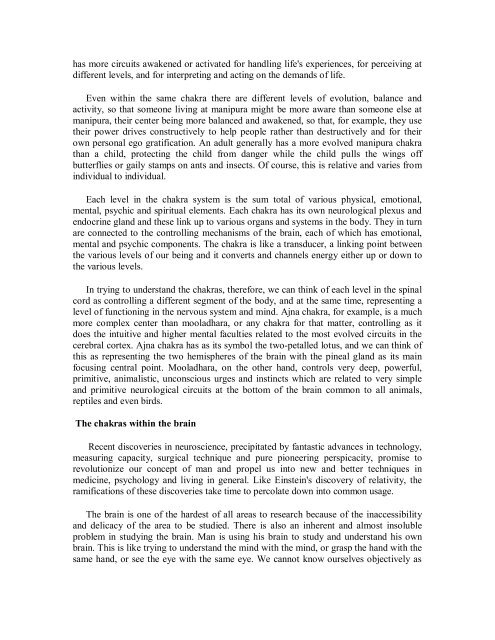Kundalini.Tantra.by.Satyananda.Saraswati
Create successful ePaper yourself
Turn your PDF publications into a flip-book with our unique Google optimized e-Paper software.
has more circuits awakened or activated for handling life's experiences, for perceiving at<br />
different levels, and for interpreting and acting on the demands of life.<br />
Even within the same chakra there are different levels of evolution, balance and<br />
activity, so that someone living at manipura might be more aware than someone else at<br />
manipura, their center being more balanced and awakened, so that, for example, they use<br />
their power drives constructively to help people rather than destructively and for their<br />
own personal ego gratification. An adult generally has a more evolved manipura chakra<br />
than a child, protecting the child from danger while the child pulls the wings off<br />
butterflies or gaily stamps on ants and insects. Of course, this is relative and varies from<br />
individual to individual.<br />
Each level in the chakra system is the sum total of various physical, emotional,<br />
mental, psychic and spiritual elements. Each chakra has its own neurological plexus and<br />
endocrine gland and these link up to various organs and systems in the body. They in turn<br />
are connected to the controlling mechanisms of the brain, each of which has emotional,<br />
mental and psychic components. The chakra is like a transducer, a linking point between<br />
the various levels of our being and it converts and channels energy either up or down to<br />
the various levels.<br />
In trying to understand the chakras, therefore, we can think of each level in the spinal<br />
cord as controlling a different segment of the body, and at the same time, representing a<br />
level of functioning in the nervous system and mind. Ajna chakra, for example, is a much<br />
more complex center than mooladhara, or any chakra for that matter, controlling as it<br />
does the intuitive and higher mental faculties related to the most evolved circuits in the<br />
cerebral cortex. Ajna chakra has as its symbol the two-petalled lotus, and we can think of<br />
this as representing the two hemispheres of the brain with the pineal gland as its main<br />
focusing central point. Mooladhara, on the other hand, controls very deep, powerful,<br />
primitive, animalistic, unconscious urges and instincts which are related to very simple<br />
and primitive neurological circuits at the bottom of the brain common to all animals,<br />
reptiles and even birds.<br />
The chakras within the brain<br />
Recent discoveries in neuroscience, precipitated <strong>by</strong> fantastic advances in technology,<br />
measuring capacity, surgical technique and pure pioneering perspicacity, promise to<br />
revolutionize our concept of man and propel us into new and better techniques in<br />
medicine, psychology and living in general. Like Einstein's discovery of relativity, the<br />
ramifications of these discoveries take time to percolate down into common usage.<br />
The brain is one of the hardest of all areas to research because of the inaccessibility<br />
and delicacy of the area to be studied. There is also an inherent and almost insoluble<br />
problem in studying the brain. Man is using his brain to study and understand his own<br />
brain. This is like trying to understand the mind with the mind, or grasp the hand with the<br />
same hand, or see the eye with the same eye. We cannot know ourselves objectively as














![[Lonely Planet] Sri Lanka](https://img.yumpu.com/59845622/1/169x260/lonely-planet-sri-lanka.jpg?quality=85)


